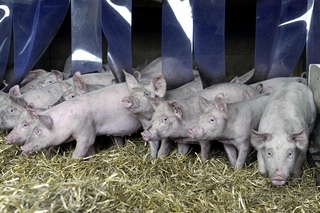USA feared summer foot and mouth outbreak

Secret White House briefings and intelligence meetings smack more of a potential Al-Qaeda terrorist threat than an outbreak of foot and mouth disease, but according to the US government, they could be one and the same.
In June this year, suspicious lesions were found on a shipment of 200 pigs in Austin, Minnesota, home of Hormel Foods Corp. and also known as “Spamtown, USA”, it has emerged.
And because symptoms were classical of foot and mouth, federal authorities immediately quarantined the animals and began testing. Homeland Security was notified, who in turn coordinated response through their National Operations Centre.
Animals in Iowa were isolated as dangerous contacts, and the consignment was traced back to Canada, where inspectors inspected the farm for any signs of the contagious disease.
These procedures were kept secret for fear they would scare consumers, panic potential investors and potentially cause colossal losses. A suspected case of foot and mouth in the USA in 2002 cost the beef industry $50m in sales alone.
Roger Rufe, director of operations coordination at the Homeland Security Department justified the approach by saying: “We wanted to keep it quiet to the extent we could so it wouldn’t cause any panic or economic impact, but make sure the people who would be most concerned, like the President or the secretary, knew what we were doing.”
While tests were being carried out, White House anti-terrorism officials were briefed and any possible intelligence on terrorist links were sought.

“One of the first things you have to worry about is, if it was foot and mouth, was it an attack,” Mr Rufe said.
Suspicions raised, the strategy quickly gravitated to include departments of State, Transportation and Health Services.
However, within two days of the lesions being found, lab testing revealed the infection was not foot and mouth, and instead an illness which posed threat to neither humans or the livestock industry.
Although the outbreak never materialised, procedures implemented indicated how the US government would react to a foot and mouth epidemic.
US Department of Agriculture officials said the false alarm had been a good test, revealing gaps in communications systems for additional training.
Mr Rufe added that, in the past, Homeland Security would not have necessarily been involved in a foot and mouth outbreak.
“But Hurricane Katrina highlighted the need for someone to coordinate and bring the effort together. This was a good chance to work on that and get it smoothed out.”
